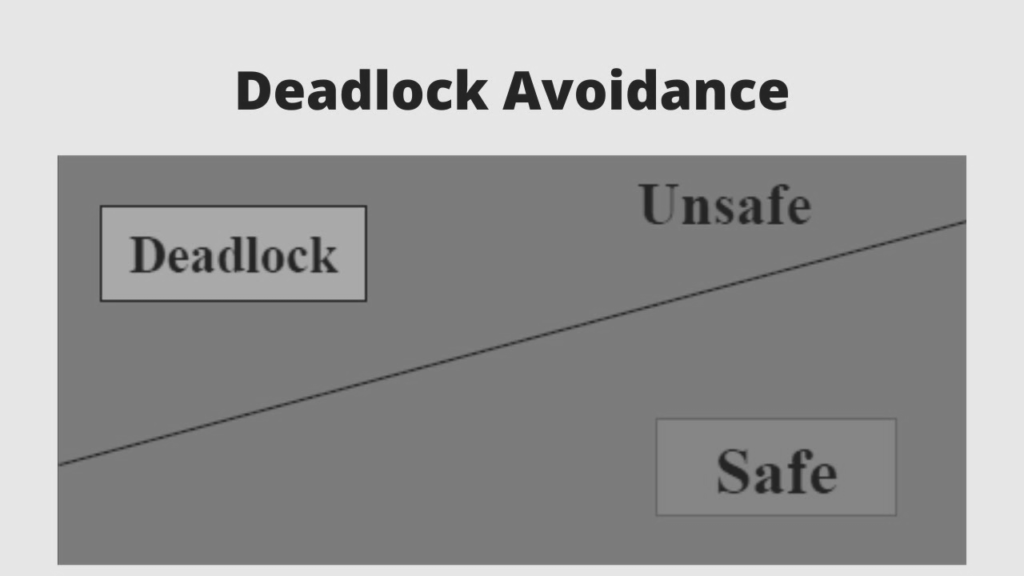How to prevent and handle deadlock avoidance?

Almost any circumstance in which processes share resources can result in a deadlock. It is common in distributed systems, where multiple processes use different resources, but it can occur in any computing environment. Deadlock avoidance in OS to steer clear of a deadlock. Before beginning a process’s execution, the operating system will keep a log of the maximum resources required throughout its life cycle. Before allocating any newly requested resource to any process, the operating system will regularly check the system’s state. A safe state exists when the operating system can allocate all of the requested resources to the process without subsequently causing a deadlock. Additionally, the OS is unsafe if it cannot allocate all requested resources without resulting in a future deadlock.
Deadlock avoidance in os: What are the methods included in deadlock avoidance?
Common approaches to avoiding a deadlock include:
Wound/wait
If a process that holds the resource is also requesting an unavailable resource, this method will kill or hurt the process that requests the resource. The resource will need to be requested once more by the process that was killed later.
Banker’s algorithm
A variation of the resource allocation graph algorithm is this; the algorithm uses information about the maximum and available resources for each process and checks for a safe state before allocating resources.
Wait/die
A process that asks for a resource that isn’t available will wait until the resource is available using this approach. The process that has been waiting for the longest will be allowed to proceed if the process that holds the resource is also requesting an unavailable resource.
Resource allocation
The operating system can use algorithms to check for safe states before allocating resources by representing the processes and resources as nodes in a graph. These are some of the typical approaches taken in deadlock avoidance in OS. The system’s requirements and available resources determine the best approach.
Deadlock avoidance in OS example
A system can change from being safe to being unsafe. Let’s say that process P3 requests one more tape at time t1. There is no longer a safe state for the system. Process P2 is the only one that can be given all of its tapes at this point. The system will then only have four tapes available when it returns them. P1 may request five additional tapes because it has a maximum of ten tapes but is given five. Because they are unavailable, it will have to wait if this happens. Similarly, process P3 may have to wait to request its additional six tapes, which causes a deadlock. The primary principle of the deadlock avoidance strategy is that whenever a request for resources is made, it must only be approved if the resulting state is safe.
Deadlock detection in OS
In this approach, the OS does not use any mechanisms to avoid or prevent deadlocks. The system predicts that a deadlock will occur as a result. To avoid deadlocks, the operating system periodically checks the system. Suppose any deadlock avoidance in OS will try to restore the system in various ways. Deadlock detection is the OS’s primary responsibility. The OS can identify deadlocks with the assistance of the resource allocation graph. In a system with single-instanced resource types, there will almost certainly be a deadlock if a cycle forms. In contrast, detecting a cycle is insufficient in a graph of the multiple-instanced resource type. We must apply the safety algorithm to the system by transforming the resource allocation graph into the allocation and request matrix.
FAQs about Deadlock avoidance in os:
What are the methods for deadlock avoidance?
Deadlock is a common issue in multiprocessing when multiple processes share a particular kind of mutually exclusive resource, known as a software lock or soft lock.
What is deadlock prevention and deadlock avoidance in OS?
Blocking at least one of the four conditions necessary for the deadlock to occur is known as deadlock prevention. Deadlock can be avoided if we can block any of them.
In Deadlock avoidance, we need to anticipate deadlock before it occurs to prevent the system from entering an unsafe state. If resources are carefully allocated, it is possible to avoid a deadlock.
Conclusion
The operating system utilizes Deadlock Avoidance to prevent deadlock by utilizing Banker’s algorithm or the resource allocation graph. It tells the operating system what resources are needed for the process to finish, and the system then checks to see if the requirements can be met.